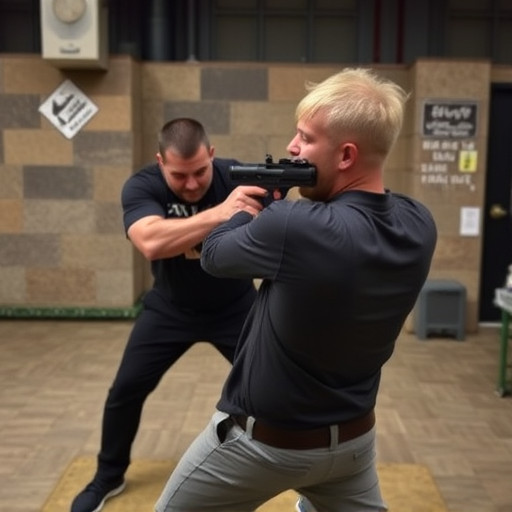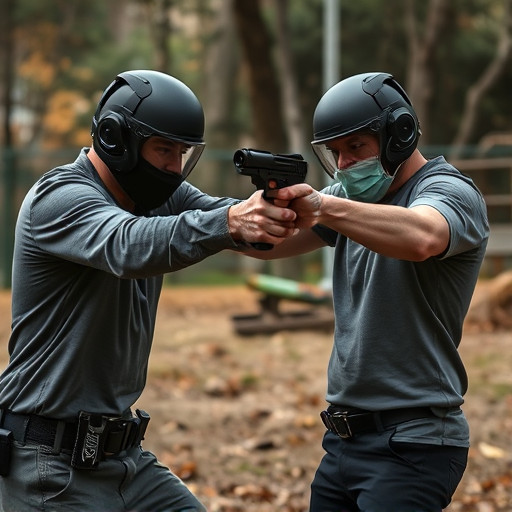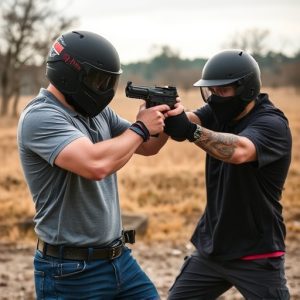Stun Guns Safety & Selection: Projectile vs Contact Weapons
Stun weapons come in two types: projectile (like stun guns or tasers) and contact devices (stun bato…….
Stun weapons come in two types: projectile (like stun guns or tasers) and contact devices (stun batons or cuffs). Projectile tools operate from a distance, using electric currents or projectiles to temporarily disable targets, while contact stun weapons deliver shocks upon direct physical interaction. For beginners, stun guns with safety features like trigger locks, adjustable output settings, LED lights, and vibration alerts are recommended for responsible use. These devices offer powerful yet non-lethal protection in various scenarios, with projectile weapons providing distance protection and contact devices offering immediate close-range shock. Beginners should select weapons based on their typical situations and environment to ensure safety and control.
In the realm of personal defense, stun weapons have emerged as a game-changer. This article delves into the critical distinction between projectile and contact stun weapons, offering insights tailored for those new to these devices. We explore safety features in stun guns essential for beginners, guiding them in choosing the right weapon based on unique needs. Discover how advanced technology ensures effectiveness while prioritizing user safety, making stun guns with built-in safety features ideal for those looking to protect themselves in today’s bustling world.
- Understanding Projectile and Contact Stun Weapons
- Safety Features in Stun Guns for Beginners
- Choosing the Right Stun Weapon Based on Your Needs
Understanding Projectile and Contact Stun Weapons

Stun weapons can be broadly categorized into two types: projectile and contact stun devices. Projectile stun weapons, like stun guns or tasers, operate by firing an electric current or a projectile at the target from a distance. These weapons are designed to temporarily incapacitate individuals without causing significant physical harm, making them popular choices for self-defense among beginners who prioritize safety. With advanced safety features, such as automatic shut-off mechanisms and reduced shock levels, stun guns offer users a non-lethal option for personal protection.
Contact stun weapons, on the other hand, make direct contact with the target. These include tools like stun batons or stun cuffs, which deliver an electric shock when pressed against or worn on the body of the intended subject. Unlike their projectile counterparts, these devices require physical interaction, making them more suitable for close-quarters situations. Beginners should understand that while both types have their advantages and safety measures, proper training and familiarization with the specific weapon are crucial to ensure effective and responsible use.
Safety Features in Stun Guns for Beginners

For beginners considering stun guns, prioritizing safety is paramount. Stun guns with safety features designed specifically for novice users offer a secure way to learn and practice self-defense. These models often include trigger locks that prevent accidental discharges, ensuring the device remains inactive until intentionally activated by the holder. Additionally, stun guns equipped with stun levels or adjustable output settings allow beginners to familiarize themselves with the weapon’s effectiveness without delivering a potentially overwhelming shock.
Moreover, many stun guns for beginners incorporate bright LED lights as an additional safety measure. These lights can be used in low-light environments to disorient attackers and provide a crucial split second for escape. Some models even feature vibration alerts that signal when the stun gun is activated, further emphasizing the need for deliberate control before deployment. These integrated safety features foster responsible ownership and usage, making stun guns an attractive option for personal protection beginners.
Choosing the Right Stun Weapon Based on Your Needs

When choosing a stun weapon, understanding the difference between projectile and contact-based devices is key. For beginners looking for a safe yet effective option, stun guns with built-in safety features are ideal. These tools offer a non-lethal means of self-defense by delivering a powerful electric shock, neutralizing an attacker without causing permanent harm.
Projectile stun weapons, such as stun guns or tasers, shoot small probes that deliver the electrical charge from a distance, making them suitable for situations where you might not be in direct contact with the assailant. Contact stun devices, on the other hand, require physical touch to deploy their shock, providing immediate and close-range protection. Beginners should consider their typical self-defense scenarios and environment when selecting between these two types, ensuring they choose a weapon that aligns with their needs and offers the desired level of safety and control.
When selecting a stun weapon, especially for beginners, prioritizing safety is paramount. Stun guns with integrated safety features offer a secure option for personal protection. By understanding the differences between projectile and contact stun weapons and choosing the right tool based on individual needs, users can make informed decisions. Remember, proper training and adherence to safety guidelines are essential for responsible stun weapon ownership. With the right knowledge, these devices can provide peace of mind in potentially dangerous situations.


